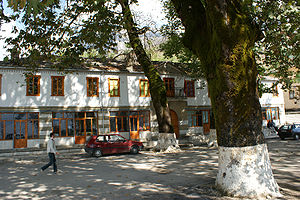Libohova
|
Libohovë Libohova |
||

|
||
|
Coordinates: 40 ° 2 ′ N , 20 ° 16 ′ E |
||
| Basic data | ||
|---|---|---|
| Qark : | Gjirokastra | |
| Municipality : | Libohova | |
| Height : | 530 m above sea level A. | |
| Area : | 248.24 km² | |
| Bashkia residents : | 3667 (2011) | |
| Population density (Bashkia): | 15 inhabitants / km² | |
| Telephone code : | (+355) 881 | |
| Postal code : | 6003 | |
| Politics and administration (as of 2019 ) | ||
| Mayoress : | Luiza Mandi ( PS ) | |
| Website : | ||
 Downtown Boulevard (2008) |
||
Libohova ( Albanian also Libohovë ) is a small town in southern Albania . The place, which today has less than 2,000 inhabitants (2011), belongs to the Gjirokastra Qark and is located on the slopes of the Shëndëll- Lunxhëria - Buretoja mountain range below the Buretoja ( 1763 m above sea level ) northeast above the Drino Valley . To the south, the Greek border is barely 15 kilometers as the crow flies.
description
The city, which was much larger in earlier times, now has a more rural character. In the center there is a long boulevard, the development of which mainly dates from the communist period (1944–1990). An older complex of buildings from the 19th century was the residence of the local ruling family. At the end of the boulevard is a huge plane tree , over 500 years old , which is said to be one of the largest trees of its kind in Europe. The most notable building in the city is a mountain fortress built around 1800 . The rest of the city area is taken up by farms, between which extensive fallow land and gardens extend. Here and there ruins of the earlier buildings can still be seen.
history
The aristocratic family is named after Libohova, who provided the local rulers here for centuries and whose members such as Eqrem Bej Libohova played an important role in Albanian politics until the interwar period.
The city experienced its heyday in the 19th century. At the beginning of this, the Libohovas entered into an alliance with Tepedelenli Ali Pascha , who ruled all of Epirus at that time . Ali Pasha married one of his sisters in Libohova and from then on held his hand over the city, which became an important market town in the region. At that time the place had more than 15,000 inhabitants. Even after the fall of its powerful protector, the Libohova family was able to ensure good development of their city for several decades. The decline began at the end of the 19th century, and migration began. The latter could only be slowed down by repression even during the communist era and increased sharply after the political change in 1990.
During World War II , Libohova was a center of the communist partisan movement . The place could already be liberated in February 1943, while the nearby Gjirokastra was occupied by the Germans for over a year longer .
local community
Until 2015, the municipality ( bashkia ) Libohova only included the city. Then the surrounding municipality of Qendër Libohova (1264 inhabitants) and the municipality of Zagoria (411 inhabitants) in the north of the mountains were incorporated. The community has a total of 3667 inhabitants (as of 2011). In terms of population, it is the third smallest municipality in the country .
Personalities
- Myfit Libohova (1876-1927), politician
- Avni Rustemi (1895–1924), educator and politician
literature
- Gillian Gloyer: Bradt Albania (Bradt Travel Guide Albania) . 2nd Edition. Bradt Travel Guides, Chalfont St. Peter 2006, ISBN 1-84162-149-8 , p. 149 f .
Web links
- Official website of the Bashkia (Albanian)
Individual evidence
- ↑ Ines Nurja: Censusi i popullsisë dhe banesave / Population and Housing Census - Gjirokastër 2011 . Results Kryesore / Main Results. Ed .: INSTAT . Pjesa / Part 1. Adel Print, Tirana 2013 ( instat.gov.al [PDF; accessed April 14, 2019]).

